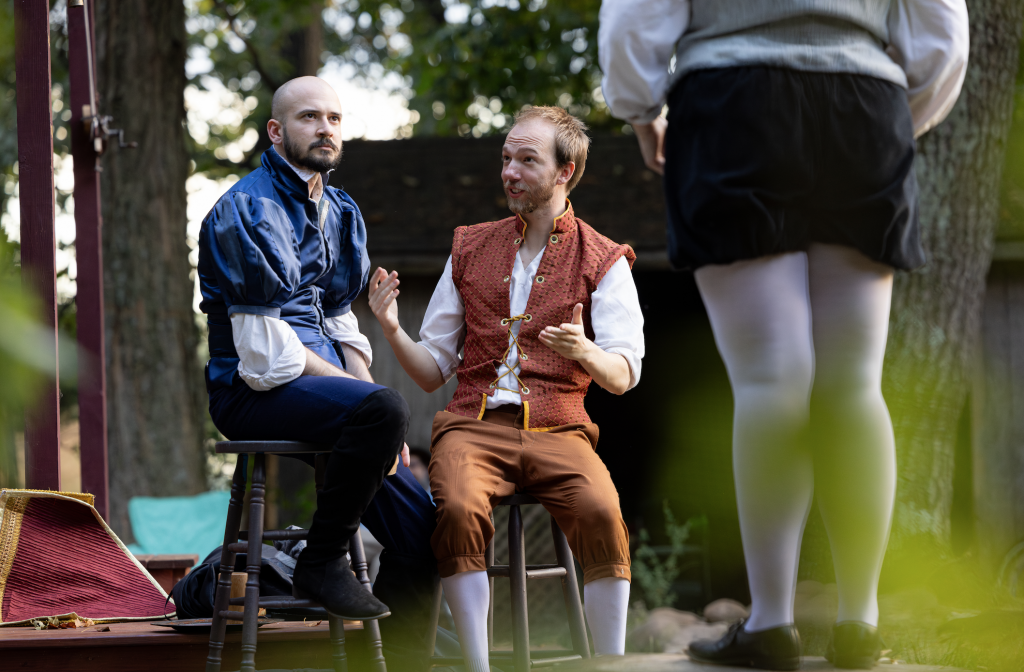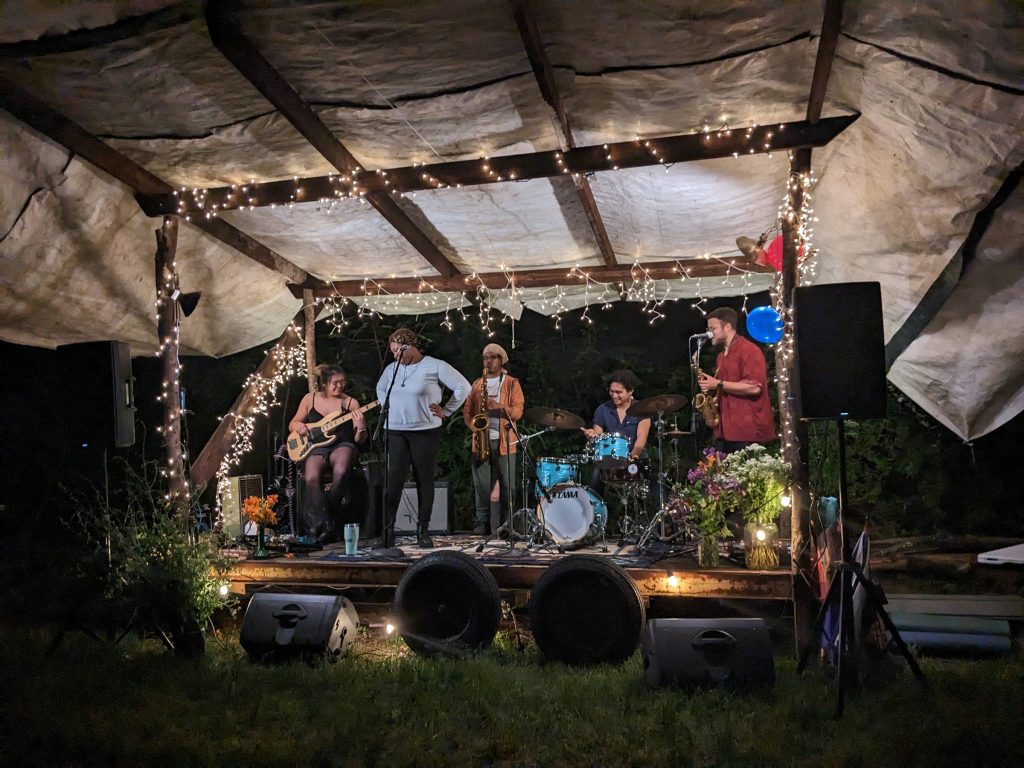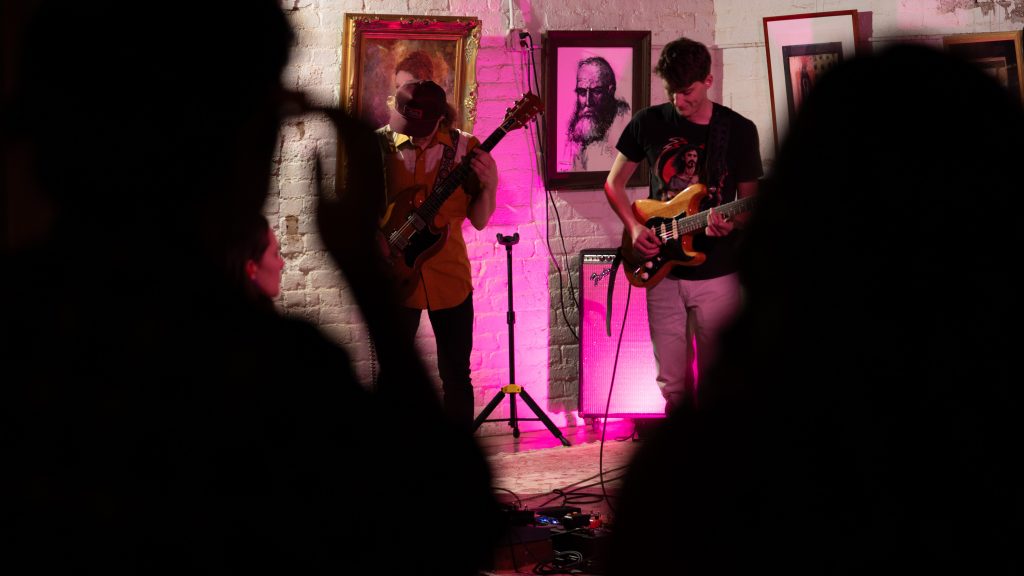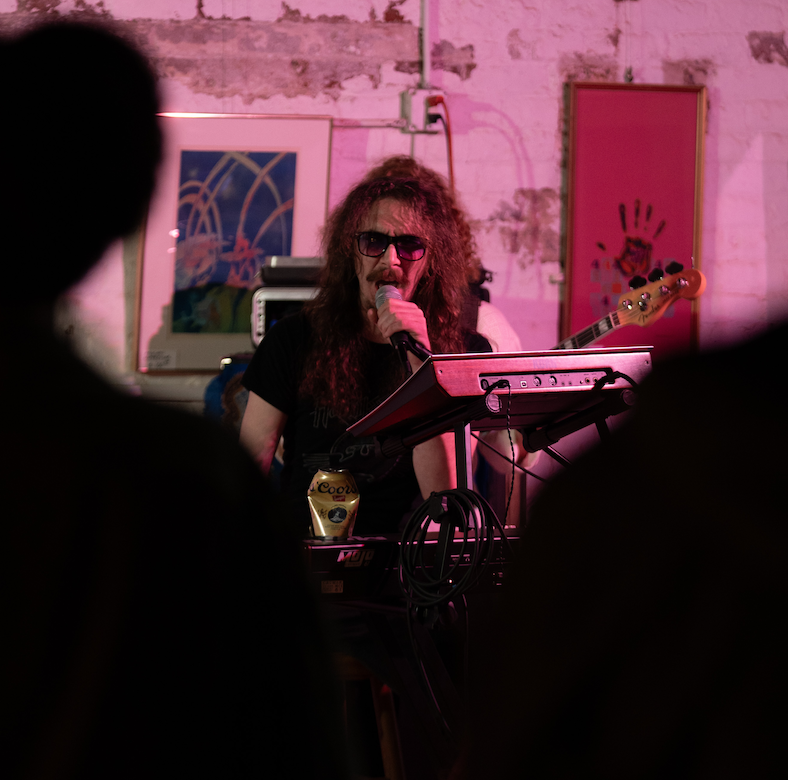A chilly March night, and the indoor space seems to be unheated. It’s not designed to be comfortable; it’s an industrial building in Harrisonburg repurposed as a climbing gym that also hosts music, and it has a concrete floor, a loft reached by a ladder missing a rung, and odd couches and crates. People bob heads and dangle their feet. Eleagnus singer Taylor Hanigosky, wearing coveralls, pushes a metal dolly around a big cardboard Amazon box that’s been set in the middle of the room with a small basketball hoop taped to its side. She struggles to slide the dolly under the box; inside is another performer who, after Hanigosky wheels the box closer to her bandmates, will push her arms and legs through holes in its sides and stand, the upside-down Amazon smile becoming a creature’s frowning face, earning cheers from the audience. A few songs later, Hanigosky talk-sings over a groove laid down by her partner Jordan Fust and their bandmate Mahi Doiron, while the space’s booker, who goes by Shoz, watches rapt from near the wall.
Named after the Latin name for autumn olive—an invasive shrub that also makes edible berries—Eleagnus is the musical wing of an expansive partnership between Hanigosky, Fust, and a network of other people. They do many kinds of work: selling products at farmers’ markets; visual art in media like felting and screen-printing; performance art; river restoration.
All of this work has a distinctly DIY ethos that depends on community to come alive. “I just feel super passionate about … people being able to make art happen,” Shoz says, adding that before this underground space started hosting music, it was hard for fringe acts to find a venue in Harrisonburg.
All this work, too, is firmly based in a specific place: the Shenandoah Valley—which, despite being reachable in less than 35 minutes from Charlottesville, can feel a world apart. The Valley’s public image is often more connected to agriculture, as though it were a slice of the Midwest slotted into Virginia’s rolling landscape. Yet it only takes a little digging to realize that the Valley supports its own crop of experimental and innovative artists.
Arts initiatives

Supplied photo.
Many of their projects occur not in spite of, but in direct relation to, the Valley’s character and history. Take Silk Moth Stage, for example—a theater venue that happens to be located in Aili Huber’s yard. Artistic director Huber earned a master’s in directing through Mary Baldwin and the American Shakespeare Center and has lived with her family near Harrisonburg for 17 years. Since her home is tucked along the edge of a working dairy farm, the plays produced there fold the setting—fences, cows, silos—right into the theater experience.
“I love it when the cows come to the edge of a fence and stare,” says Silk Moth board president Holly Labbe, “or the cats come across the stage in the moment of the show and the actors respond to that. It feels very real.”
Huber, who founded Silk Moth in 2022, says the venue’s performance style owes a lot to the ASC, though rather than the Bard, 21st-century plays are her focus. And she chooses scripts that will fit well with her outdoor stage—which is actually a deck and a balcony on her house. “We can’t have anything where you have to have a set and fancy lighting effects. Some plays require a realism that isn’t going to work here. We do our shows in the afternoon, lit by the sun, and the actors and audience can see each other.”
Silk Moth has been producing just two shows per year—that’s the right number, Huber says, considering she relies on her neighbors to provide parking, and because she herself is sometimes busy directing plays elsewhere in the U.S. This year’s season opened May 10 with a production of Underneath the Lintel, a play by Glen Berger that maps the time-traveling adventure of a mystery-solving librarian.
Huber is deeply invested in the ethics of how a play comes before an audience—from the way directors treat actors to which audience members are made to feel welcome. Silk Moth has partnered with groups serving low-income and unhoused people to bring their clients to performances, providing not only tickets but transportation, meals, and child care. It also cultivates ties to local organizations like libraries and LGBTQ centers and has a fund to subsidize free and reduced ticket prices. “While our published ticket price is $34, our average last year was $20 when you factor in free and reduced,” Huber says. “A budget is a moral document.”
She also makes a point of paying actors and other collaborators—“To the best of my knowledge, there are only two other theaters within a two-hour drive of us that pay artists consistently, and we have a plan to pay people on a union scale by our fifth season,” she says proudly—and strives to create a “radically welcoming” experience for actors.
“Theater is generally really bad for the people who make it,” she says. “Just as a matter of tradition, we have these practices in terms of teaching or directing that are not good for people. We ask them to bring their own trauma to the surface of our art, and costume designers say horrible things about people’s bodies. I set out to create a new framework, where the core principle is we’re humans with needs, and we should have the right to radical consent about our bodies and inner spaces.” She calls her framework “Take5” because one of its tenets is that actors can ask for a five-minute break at any time.
Most Silk Moth actors are local, but this is not community theater. “People come to see our shows and they’re always a little shocked at the quality. It elevates this community in the eyes of people from elsewhere. I want this to be a destination.”
Breaking convention

Supplied photo.
Separate from Charlottesville but not exactly part of Appalachia, the Valley is its own center of gravity. For Hanigosky, who grew up in the Rust Belt environs of Youngstown, Ohio, it’s a home she adopted after living on the West Coast, where she met Fust on a permaculture and fiber farm in Washington state.
“I got really immersed in fiber and it was a completely transformative experience,” she says. “Farming helped me understand a pathway to having a relationship with place. It caused me to reckon with my own trajectory from Ohio west and why I made that decision … I started to wonder if my gifts, my skills, my dreams could be more useful applied in a context that wasn’t about leaving and starting somewhere fresh but was about returning and dealing with the harm that’s been caused in a place.”
Because Fust’s family had lived in Stuarts Draft for six generations, the Valley offered itself as a place where the two of them could dig into a landscape with personal connections. The pair moved there in 2019 and named it Wild Altar Farmstead, and the pandemic saw them quickly expanding their garden beds and selling at farmers’ markets in Waynesboro, Harrisonburg, and Staunton. Yet simply building a produce operation wasn’t their goal.
“You have to get efficient and tight with margins, but that’s not our path,” she says. “We’re really interested more in the relationship to land and trying to engage with the community and bring more people into the possibility of that relationship.” If, for example, they make jam out of those invasive autumn olive berries, “it opens up this whole world where you talk about why it’s here and what can we do about it. We can eat it! Food becomes this center of a relationship.”
At the same time, Hanigosky and Fust stay connected to their art practices through performing with Eleagnus, making visual work, and offering fiber arts workshops. They marry food and art by using Staunton’s Art Hive as a place to teach fermentation and seasonal cooking. They’ve even undertaken dance and performance art at the former site of the Staunton Mall.
“It came from this desire to witness places that are in transition, to spend time lingering in places caught up in the human development and redevelopment cycle,” she explains. “What does the land have to say about that? How are we witnessing this really rapid change?”

Photo by Nick Saraceno.
The documentation of their work at the mall became an exhibition and performance in May at an intriguing new gallery/performance space in Staunton called the SolArt Center. Located on the basement level of a 160-year-old brick building, SolArt is the creation of Wes Wyse, who owns the vintage store Eclectic Retro upstairs, and Rachel Towns.
“We were talking and saying, wouldn’t it be cool to have an arts space?” Wyse says, recalling their vision for a fringe-friendly spot that could accommodate music, small-scale theater, film, art, and other offerings. SolArt opened last November, hosting a popular zine fair as one of its first events. “We packed people in,” says Wyse. “After three months, it became clear that it was taking on a life of its own.”
By explicitly inviting local creatives to bring their ideas and projects, everything from medicinal mushroom classes to battle-jacket workshops, SolArt has made itself accessible and DIY-centric. The building itself—think walls made of giant stones and mismatched furniture—is a big part of the appeal. “The space has such a great vibe, it lends itself to certain types of music—folk, ambient, experimental drone things,” Wyse says. “[We did] a punk market in May. It builds on itself.”
Like everyone else in this story, he and Towns take pleasure in midwifing the projects of others. “These are the artists and musicians who don’t fit Beverley Street or the Downtown Mall,” Wyse says. “I think there is a movement of DIY outsider art.”
The fact that the Wild Altar artists form a bridge between SolArt and Shoz is emblematic of the spirit of connection animating the scene here. “Definitely the work that’s been most motivating to me has been collaborative,” says Hanigosky. “That’s been really exciting about being in the Valley.”

